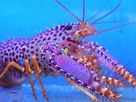Spiny Blue Lobster - Panulirus versicolor - Spiny Lobsters

Taxonomy: Spiny Blue Lobster belongs to the Kingdom Animalia, Phylum Arthropoda, Class Crustacea, Order Decapoda, Family Palinuridae, Genus Panulirus and Species versicolor.
Scientific names: The scientific name of Spiny Blue Lobster is Panulirus versicolor
Other common names: Spiny Blue Lobster is also commonly known as Spiny Lobster, Painted Lobster, Painted Crayfish, Painted Spiny Lobster, Purple Spiny Lobster, Blue Spiny Lobster, Spiny Blue Lobster and Painted Rock Lobster.
Origin or natural range: Panulirus versicolor is found in the tropical Indo-Pacific region.
Size: Spiny Blue Lobster grows up to an approximate size of fourteen inches.
Color: Panulirus versicolor occurs in black, green, white and blue colors.
Compatibility: Spiny Blue Lobster is aggressive towards the other aquarium members.
Habit & Habitat:
- Panulirus versicolor is found on the rocky coral reef.
- Spiny Blue Lobster is nocturnal in nature and therefore, is active at night which includes searching for food in sand or rubble and feeding.
- Panulirus versicolor is hardy.
- The body, the legs and the tail of Spiny Blue Lobster are all patterned with azure blue stripes.
- The body of Panulirus versicolor is segmented and the abdomen is patterned with white bands.
- The dorsal surface of the carapace of Spiny Blue Lobster has mesh like pattern and is greenish blue in color.
- Panulirus versicolor does not have large sized claws and has significantly long antennae.
- Temperature of water: Seventy-two to seventy-eight degrees Fahrenheit.
- Specific gravity of water: 1.023 to 1.025.
- pH of water: 8.10 to 8.40.
- Illumination: Spiny Blue Lobster requires light in the marine aquarium it inhabits.
- Habit & habitat:
- To host Panulirus versicolor, you should have a large sized marine aquarium. The size of Spiny Blue Lobster may require caution in its admission into a reef type marine aquarium.
- Keep some rocks and rock caves at adequate gaps in your reef tank for Panulirus versicolor to hide properly during the day time.
- You can keep only one Spiny Blue Lobster or a mating pair of it in your marine aquarium.
- Feeding & Nutrition: Panulirus versicolor is Omnivorous in feeding habit and at night, eats phytoplankton, the meaty bits of seafood and small sized and medium sized fish.
- Breeding: Spiny Blue Lobster may not breed in a marine aquarium at all. Even if it does, the process will involve a lot of complications.
- Benefits:
- Panulirus versicolor searches for its food in the sand by ploughing it and in the process aerating it.
- Spiny Blue Lobster cleans your marine aquarium by eating the detritus present in the sand. If left to stay, the detritus will rot and will eventually contaminate the tank's water.
- Human beings consume Panulirus versicolor as one of the seafoods.
- Spiny Blue Lobster is easy to maintain owing to its non-poisonous nature.
- The high levels of Copper and Nitrates in the marine aquarium water may be detrimental to the health of Panulirus versicolor.
- Regularly feed Spiny Blue Lobster, especially with meaty bits. The feeding should be in a regulated amount and Panulirus versicolor should not be overfed.
- Owing to its large size, Spiny Blue Lobster may prove destructive for a reef type marine aquarium as it may damage fish, corals and anemones present therein.
- Panulirus versicolor may disturb sessile and bottom dwelling members of your marine aquarium. To avoid this situation, keep the lobster very well fed.
- Do not keep more than one Spiny Blue Lobster or a mating pair of it in your marine aquarium, as together they may be considerably aggressive towards each other as well as towards the other tank members.

Purple and Orange Lobster - Enoplomentopus debelius - Red Lobster - Debelius Reef Lobster
Freshmarine: $29.98
You Save 25.03%
Before Placing Your Order
Store InformationShipping Info
Payment Info
Return Policy
Arrive Alive Guarantee
Adoptation Policy
After Placing Your Order
Track Your OrderSecurity Safe Shopping
Compatibility Chart
Shoppers Review







